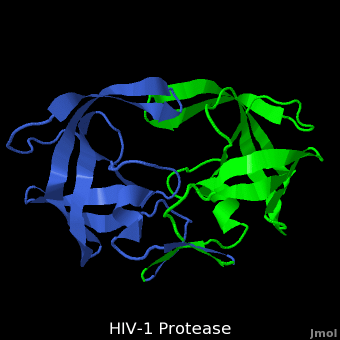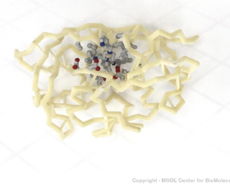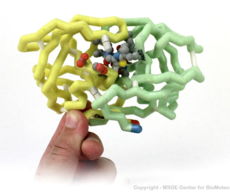Immunodeficiency virus protease
From Proteopedia
FunctionHuman Immunodeficiency Virus (HIV) is the cause of Acquired Immunodeficiency Syndrome (AIDS). HIV directs the synthesis of several polyproteins, which each consist of several tandemly linked proteins. The maturation of the virus to its infectious form requires that these polyproteins be cleaved to their component proteins. , a homodimeric enzyme, is responsible for doing so and is therefore crucial to the virus's infectious capacity. See also:Flaps Morph for HIV Protease. Structure of HIV-1 ProteaseThe X-ray structure of HIV-1 protease[2][3] reveals that it is composed of , each consisting of 99 amino acid residues. The subunits come together in such as way as to . This tunnel is of critical importance because the active site of the protease is located in its interior. The active site consists of , making it a member of the aspartyl protease family. The two Asp's are either interact with the incoming water OR protonate the carbonyl to make the carbon more electrophilic for the incoming . You may be wondering how a polyprotein makes its way into the active-site tunnel, as the to admit it. The key is the two flexible flaps on the top of the tunnel that to enter the tunnel. The flaps , shifting from an open to a closed conformation to bind the target in an appropriate conformation for cleavage. This is more clearly seen at Flaps Morph for HIV Protease. Medical ImplicationsThere currently is no cure or vaccine against HIV. Researchers, however, have discovered treatments that can halt and even reverse the progression of AIDS, due in large part to our understanding of the structure of HIV-1 protease. (Invirase) was the first protease inhibitor approved by the FDA for the treatment of HIV. It inhibits HIV protease by , preventing the binding of polyproteins. Its chemical structure mimics the tetrahedral intermediate of the hydrolytic reaction, thereby .[4] Saquinavir is essentially an uncleavable ligand, as indicated by the on binding saquinavir or a polypeptide. Resistance to saquinavir is due to alterations in the HIV protease sequence, including the mutation of [5]. Drugs used to treat HIV infection that inhibit include (Crixivan), (Norvir), Saquinavir, Tipranavir, Amprenavir (Agenerase), Atazanavir (Rayataz), Darunavir (Prezista), Fosamprenavir (Lexiva or Telzir), Lopinavir (Kaletra), Nelfinavir (Viracept) and (Viracept). See also Treatments:HIV Protease Inhibitor Pharmacokinetics References Structural Insights into the South African HIV-1 Subtype C Protease: Impact of hinge region dynamics and flap flexibility in drug resistance [6]The current study reports on the apo crystal structure of the . Structure of with the active site triplet (D25, T26 and G27) shown in ball-and-stick representation, hinge region in magenta (residues 35–42 and 57–61), and flap region (residues 46–54) in cyan. The relevance of this study cannot be underestimated because South Africa is at the epicenter of the HIV/AIDS pandemic. A detailed understanding of the molecular interactions between the drug and its target is required if we are to improve the design of protease inhibitors (PIs). Our study indicated that the loss of a salt bridge between at the hinge region affects the flap dynamics of the apo C-SA PR which may reduce the affinity and, therefore, the efficacy of the current protease inhibitors toward the C-SA PR (subtype C-SA PR is in deeppink, 3u71 and subtype B PR is in yellow, 2pc0). of of the C-SA PR (deep pink, PDB ID: 3u71), consensus subtype B PR (yellow, PDB ID: 2pc0), and subtype B-MDR PR (color wheat, PDB ID: 1rp1) reveals that the PRs under investigation do not differ significantly. The crystal structure of the C-SA PR will serve as a foundation to improve the rational design of PIs which will have a greater impact on anti-retroviral chemotherapy in sub-Saharan Africa. 3D Printed Physical Model of HIV ProteaseShown below are 3D printed physical models of HIV Protease. Both versions are shown in alpha carbon format, with select side chains shown colored by element, with carbon gray, nitrogen blue, oxygen red and sulfur yellow. Both models have been designed with precisely embedded magnets that allow the two chains to pull apart into individual pieces. The MSOE Center for BioMolecular Modeling The MSOE Center for BioMolecular Modeling uses 3D printing technology to create physical models of protein and molecular structures, making the invisible molecular world more tangible and comprehensible. To view more protein structure models, visit our Model Gallery.
HIV Protease Movie
Additional resources
Immunodeficiency virus protease 3D structuresImmunodeficiency virus protease 3D structures References
| |||||||||||
Proteopedia Page Contributors and Editors (what is this?)
Joel L. Sussman, Michal Harel, Eran Hodis, Mark Hoelzer, David Canner, Eric Martz, Ann Taylor, Wayne Decatur, Alexander Berchansky, Jaime Prilusky, Karsten Theis
DOI: https://dx.doi.org/10.14576/315240.1864715 (?)Citation: Hodis E, Sussman J L, Martz E, Canner D, Harel M, Prilusky J, Berchansky A, 2013, "HIV-1 protease",




